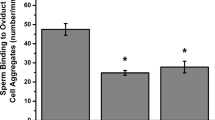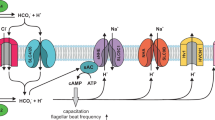Abstract
Steroid hormone progesterone released by cumulus cells surrounding the egg is a potent stimulator of human spermatozoa. It attracts spermatozoa towards the egg and helps them penetrate the egg’s protective vestments1. Progesterone induces Ca2+ influx into spermatozoa1,2,3 and triggers multiple Ca2+-dependent physiological responses essential for successful fertilization, such as sperm hyperactivation, acrosome reaction and chemotaxis towards the egg4,5,6,7,8. As an ovarian hormone, progesterone acts by regulating gene expression through a well-characterized progesterone nuclear receptor9. However, the effect of progesterone upon transcriptionally silent spermatozoa remains unexplained and is believed to be mediated by a specialized, non-genomic membrane progesterone receptor5,10. The identity of this non-genomic progesterone receptor and the mechanism by which it causes Ca2+ entry remain fundamental unresolved questions in human reproduction. Here we elucidate the mechanism of the non-genomic action of progesterone on human spermatozoa by identifying the Ca2+ channel activated by progesterone. By applying the patch-clamp technique to mature human spermatozoa, we found that nanomolar concentrations of progesterone dramatically potentiate CatSper, a pH-dependent Ca2+ channel of the sperm flagellum. We demonstrate that human CatSper is synergistically activated by elevation of intracellular pH and extracellular progesterone. Interestingly, human CatSper can be further potentiated by prostaglandins, but apparently through a binding site other than that of progesterone. Because our experimental conditions did not support second messenger signalling, CatSper or a directly associated protein serves as the elusive non-genomic progesterone receptor of sperm. Given that the CatSper-associated progesterone receptor is sperm specific and structurally different from the genomic progesterone receptor, it represents a promising target for the development of a new class of non-hormonal contraceptives.
This is a preview of subscription content, access via your institution
Access options
Subscribe to this journal
Receive 51 print issues and online access
$199.00 per year
only $3.90 per issue
Buy this article
- Purchase on Springer Link
- Instant access to full article PDF
Prices may be subject to local taxes which are calculated during checkout




Similar content being viewed by others
References
Publicover, S., Harper, C. V. & Barratt, C. [Ca2+]i signalling in sperm − making the most of what you’ve got. Nature Cell Biol. 9, 235–242 (2007)
Blackmore, P. F., Beebe, S. J., Danforth, D. R. & Alexander, N. Progesterone and 17 alpha-hydroxyprogesterone. Novel stimulators of calcium influx in human sperm. J. Biol. Chem. 265, 1376–1380 (1990)
Harper, C. V., Barratt, C. L. & Publicover, S. J. Stimulation of human spermatozoa with progesterone gradients to simulate approach to the oocyte. Induction of [Ca2+]i oscillations and cyclical transitions in flagellar beating. J. Biol. Chem. 279, 46315–46325 (2004)
Eisenbach, M. & Giojalas, L. C. Sperm guidance in mammals – an unpaved road to the egg. Nature Rev. Mol. Cell Biol. 7, 276–285 (2006)
Revelli, A., Massobrio, M. & Tesarik, J. Nongenomic actions of steroid hormones in reproductive tissues. Endocr. Rev. 19, 3–17 (1998)
Roldan, E. R., Murase, T. & Shi, Q. X. Exocytosis in spermatozoa in response to progesterone and zona pellucida. Science 266, 1578–1581 (1994)
Teves, M. E. et al. Progesterone at the picomolar range is a chemoattractant for mammalian spermatozoa. Fertil. Steril. 86, 745–749 (2006)
Uhler, M. L., Leung, A., Chan, S. Y. & Wang, C. Direct effects of progesterone and antiprogesterone on human sperm hyperactivated motility and acrosome reaction. Fertil. Steril. 58, 1191–1198 (1992)
Evans, R. M. The steroid and thyroid hormone receptor superfamily. Science 240, 889–895 (1988)
Losel, R. & Wehling, M. Nongenomic actions of steroid hormones. Nature Rev. Mol. Cell Biol. 4, 46–56 (2003)
Ren, D. et al. A sperm ion channel required for sperm motility and male fertility. Nature 413, 603–609 (2001)
Kirichok, Y., Navarro, B. & Clapham, D. E. Whole-cell patch-clamp measurements of spermatozoa reveal an alkaline-activated Ca2+ channel. Nature 439, 737–740 (2006)
Lishko, P. V., Botchkina, I. L., Fedorenko, A. & Kirichok, Y. Acid extrusion from human spermatozoa is mediated by flagellar voltage-gated proton channel. Cell 140, 327–337 (2010)
Carlson, A. E. et al. Identical phenotypes of CatSper1 and CatSper2 null sperm. J. Biol. Chem. 280, 32238–32244 (2005)
Carlson, A. E. et al. CatSper1 required for evoked Ca2+ entry and control of flagellar function in sperm. Proc. Natl Acad. Sci. USA 100, 14864–14868 (2003)
Qi, H. et al. All four CatSper ion channel proteins are required for male fertility and sperm cell hyperactivated motility. Proc. Natl Acad. Sci. USA 104, 1219–1223 (2007)
Kaupp, U. B., Kashikar, N. D. & Weyand, I. Mechanisms of sperm chemotaxis. Annu. Rev. Physiol. 70, 93–117 (2008)
Xia, J., Reigada, D., Mitchell, C. H. & Ren, D. CATSPER channel-mediated Ca2+ entry into mouse sperm triggers a tail-to-head propagation. Biol. Reprod. 77, 551–559 (2007)
Olson, S. D., Suarez, S. S. & Fauci, L. J. A model of CatSper channel mediated calcium dynamics in mammalian spermatozoa. Bull. Math. Biol. 72, 1925–1946 (2010)
Xia, J. & Ren, D. Egg coat proteins activate calcium entry into mouse sperm via CATSPER channels. Biol. Reprod. 80, 1092–1098 (2009)
Huang, L. et al. NNC 55–0396 [(1S,2S)-2-(2-(N-[(3-benzimidazol-2-yl)propyl]-N-methylamino)ethyl)-6-fluoro-1,2,3,4-tetrahydro-1-isopropyl-2-naphtyl cyclopropanecarboxylate dihydrochloride]: a new selective inhibitor of T-type calcium channels. J. Pharmacol. Exp. Ther. 309, 193–199 (2004)
Baulieu, E. E. Contragestion and other clinical applications of RU 486, an antiprogesterone at the receptor. Science 245, 1351–1357 (1989)
Neri-Vidaurri Pdel, C., Torres-Flores, V. & Gonzalez-Martinez, M. T. A remarkable increase in the pHi sensitivity of voltage-dependent calcium channels occurs in human sperm incubated in capacitating conditions. Biochem. Biophys. Res. Commun. 343, 105–109 (2006)
Aitken, R. J., Irvine, S. & Kelly, R. W. Significance of intracellular calcium and cyclic adenosine 3′,5′-monophosphate in the mechanisms by which prostaglandins influence human sperm function. J. Reprod. Fertil. 77, 451–462 (1986)
Schaefer, M., Hofmann, T., Schultz, G. & Gudermann, T. A new prostaglandin E receptor mediates calcium influx and acrosome reaction in human spermatozoa. Proc. Natl Acad. Sci. USA 95, 3008–3013 (1998)
Shimizu, Y. et al. Prostaglandins induce calcium influx in human spermatozoa. Mol. Hum. Reprod. 4, 555–561 (1998)
Ren, D. & Xia, J. Calcium signaling through CatSper channels in mammalian fertilization. Physiology (Bethesda) 25, 165–175 (2010)
Baldi, E. et al. Nongenomic activation of spermatozoa by steroid hormones: facts and fictions. Mol. Cell. Endocrinol. 308, 39–46 (2009)
Gellersen, B., Fernandes, M. S. & Brosens, J. J. Non-genomic progesterone actions in female reproduction. Hum. Reprod. Update 15, 119–138 (2009)
Liu, J., Xia, J., Cho, K. H., Clapham, D. E. & Ren, D. CatSperβ, a novel transmembrane protein in the CatSper channel complex. J. Biol. Chem. 282, 18945–18952 (2007)
Strünker, T. et al. The CatSper channel mediates progesterone-induced Ca2+ influx in human sperm. Nature doi:10.1038/nature09769 (this issue).
Acknowledgements
This work was funded by the UCSF Program for Breakthrough Biomedical Research.
Author information
Authors and Affiliations
Contributions
P.V.L. and Y.K. conceived the project, designed the experiments and wrote the manuscript. P.V.L. performed most of the experiments. I.L.B. helped with pilot experiments for the project. All authors discussed the results and commented on the manuscript.
Corresponding author
Ethics declarations
Competing interests
The authors declare no competing financial interests.
Supplementary information
Supplementary Figures
The file contains Supplementary Figures 1-15 with legends. (PDF 1953 kb)
Rights and permissions
About this article
Cite this article
Lishko, P., Botchkina, I. & Kirichok, Y. Progesterone activates the principal Ca2+ channel of human sperm. Nature 471, 387–391 (2011). https://doi.org/10.1038/nature09767
Received:
Accepted:
Published:
Issue Date:
DOI: https://doi.org/10.1038/nature09767
This article is cited by
-
Control of intracellular pH and bicarbonate by CO2 diffusion into human sperm
Nature Communications (2023)
-
The compound YK 3-237 promotes pig sperm capacitation-related events
Veterinary Research Communications (2023)
-
Proteome and Transcriptome Analysis of Gonads Reveals Intersex in Gigantidas haimaensis
BMC Genomics (2022)
-
Simulating nature in sperm selection for assisted reproduction
Nature Reviews Urology (2022)
-
Hyperactivation is sufficient to release porcine sperm from immobilized oviduct glycans
Scientific Reports (2022)
Comments
By submitting a comment you agree to abide by our Terms and Community Guidelines. If you find something abusive or that does not comply with our terms or guidelines please flag it as inappropriate.



